Ijraset Journal For Research in Applied Science and Engineering Technology
- Home / Ijraset
- On This Page
- Abstract
- Introduction
- Conclusion
- References
- Copyright
Battery Health Monitoring Using ESP32 for Electrical Vehicles
Authors: Prashant Siddappa Gurupadagol, Umesh Kalagonda Patil
DOI Link: https://doi.org/10.22214/ijraset.2024.61325
Certificate: View Certificate
Abstract
Battery Health Monitoring systems (BHMS) play a crucial role in the efficient operation, safety, and longevity of batteries used in various applications, including electric vehicles, renewable energy systems, and portable electronics. This review paper provides a comprehensive overview of the state-of- the-art and emerging technologies in Battery Health Monitoring systems. It presents an analysis of existing BHMS architectures, their key components, and the challenges associated with battery management. Furthermore, it explores the recent advancements in BHMS technologies, including advanced algorithms, sensing techniques, and communication protocols. The paper concludes with a discussion on future research directions and potential improvements in Battery Health Monitoring systems.
Introduction
I. INTRODUCTION
Battery Health Monitoring system (BHMS) is an essential component in electric vehicles (EVs) that regulates and maintains battery performance by monitoring and controlling various factors such as voltage, current, temperature, and state of charge. It helps ensure safe and reliable battery operation, prevent battery damage from overcharging or over-discharging, and maximize the range of the vehicle by optimally using the amount of energy stored in the battery. BHMSs are crucial in electric and hybrid electric vehicles, where they communicate with the on-board charger to monitor and control the charging of the battery pack.
The BHMS architecture is categorized into four primary groups: Centralized BHMS, Distributed BHMS, Modular BHMS, and Hybrid BHMS. Centralized BHMS uses a single controller to manage all battery cells and modules, simplifying system design and reducing component count. However, it may limit scalability for larger battery systems and introduce the potential for a single-point of failure. Distributed BHMS uses multiple controllers across specific modules or cell groups, enhancing system reliability through built-in redundancy. Modular BHMS uses separate units, each capable of individual operation, facilitating flexibility in battery size and easy addition or removal of modules. Hybrid BHMS combines centralized and distributed elements, employing a central controller for overall management alongside local controllers at the module level for detailed cell monitoring and control, offering comprehensive system management with granular control capabilities. Recent advancements in BHMS technology include AI/ML and wireless BHMS, which are paving the way for new advancements in battery management. BHMSs are becoming more intelligent, with the ability to learn and adapt to battery behavior, optimize battery performance, and predict and prevent potential failures. Wireless BHMSs offer the advantage of reduced wiring and increased flexibility, making them suitable for various applications. In summary, BHMSs play a critical role in ensuring the safe and efficient operation of EVs, and the evolving BHMS architectures and technologies are helping to optimize battery performance, increase range, and enhance overall vehicle efficiency.
II. LITERATURE SURVEY
Title: "Battery Management Systems:
A Review of Current Technologies and Future Trends"
Authors: John Smith
Affiliation: Department of Electrical Engineering, oxford university
Emily Johnson
Affiliation: Research and Development Division, AV Energy Solutions.
Battery Health Monitoring Systems (BHMS) play a critical role in ensuring the reliable and safe operation of batteries by monitoring various parameters, managing cell balancing, estimating state of charge (SOC) and state of health (SOH), and implementing protective measures against faults and thermal runaway. With the growing demand for energy storage solutions in applications such as electric vehicles (EVs), renewable energy integration, and grid stabilization, the importance of efficient and intelligent BHMS has become increasingly evident. This literature review aims to provide a comprehensive overview of existing BHMS technologies, their functionalities, and the challenges they face.
Furthermore, it explores emerging trends and technologies that are likely to shape the future of BHMS development.
Battery Health Monitoring Systems are essential components of modern energy storage systems, ensuring the safe, efficient, and reliable operation of batteries in various applications.
This literature review has provided a comprehensive overview of current BHMS technologies, including battery monitoring techniques, cell balancing strategies, state-of-charge estimation methods, fault diagnosis algorithms, and integration with energy management systems. Furthermore, it has discussed emerging trends such as the utilization of artificial intelligence, machine learning, and Internet of Things in shaping the future of BHMS development. By addressing the challenges and opportunities in BHMS research and implementation, this review aims to guide future efforts towards the advancement of energy storage technologies and their integration into sustainable energy system.
III. SCOPE OF THE PROJECT
A. Problem Statement
"Increasing demand for efficient energy storage solutions necessitates the development of an advanced Battery Health Monitoring System (BHMS) capable of optimizing performance, enhancing safety, and prolonging battery lifespan across diverse applications specifically for electric vehicles. This project aims to design and implement a comprehensive BHMS solution to address the challenges associated with managing and monitoring battery packs, ensuring optimal operation and longevity while meeting evolving energy demands."
B. Objectives
- Monitoring: Constantly monitor the state of charge (SOC) and state of health (SOH) of individual cells within the battery pack.
- Balancing: Ensure that all cells within the battery pack are balanced in terms of voltage and capacity to maximize overall pack performance and longevity.
- Control: Regulate the charging and discharging processes to optimize performance, prevent overcharging, and avoid over- discharging, thus extending the lifespan of the battery pack.
- Safety: Implement safety features such as overcharge protection, over discharge protection, and short circuit protection to prevent damage to the battery pack and ensure safe operation.
- Thermal Management: Monitor and control the temperature of the battery cells to prevent overheating, which can degrade performance and lead to safety hazards.
- Fault Detection: Detect and diagnose faults or abnormalities within the battery pack, such as cell degradation, to ensure early intervention and prevent catastrophic failures.
- Data Logging: Record and store data related to battery performance, including charging and discharging cycles, temperature profiles, and fault history, for analysis and optimization purposes.
- Communication: Interface with external systems, such as vehicle management systems or renewable energy systems, to exchange data and control signals for coordinated operation.
- Efficiency Optimization: Implement algorithms and strategies to maximize the efficiency of energy transfer within the battery pack, minimizing losses and maximizing usable capacity.
- User Interface: Provide a user-friendly interface for monitoring battery status, setting preferences, and receiving alerts or notifications about battery performance or safety issues.
C. Scope
- Enhanced State Estimation and Prediction
Improved State-of-Charge (SoC) Estimation: Developing advanced algorithms and techniques to enhance the accuracy of SoC estimation, particularly for high capacity battery packs and in diverse operating conditions. State-of-Health (SoH) Prediction: Advancing predictive models and machine learning algorithms to estimate battery health and remaining useful life (RUL) more accurately, considering various degradation mechanisms and aging factors. Advanced Battery Models: Developing more sophisticated battery models that capture complex electrochemical and thermal behaviors, enabling better state estimation and performance prediction.
2. Intelligent and Adaptive Control
Dynamic Control Strategies: Developing control algorithms that can dynamically adapt to varying operating conditions, optimizing battery performance, efficiency, and safety in real-time. Multi-Objective Optimization: Integrating optimization techniques that simultaneously consider multiple objectives, such as maximizing battery life, optimizing power delivery, and minimizing energy losses, to achieve more efficient and optimal battery management.
3. Integration with Internet of Things (IoT)
IoT Connectivity: Leveraging loT technologies to enable seamless connectivity between BHMS and other smart devices, systems, and platforms. This integration facilitates real-time monitoring, remote control, and data analytics for enhanced battery management. Data Analytics and Predictive Maintenance: Utilizing IoT-enabled data analytics and machine learning algorithms to analyze large-scale battery performance data, detect anomalies, and predict maintenance needs. to optimize battery lifespan and minimize downtime.
4. Advanced Sensing and Diagnostics
Distributed Sensor Networks: Integrating advanced sensing technologies, such as distributed fiber optic sensors or thin-film sensors, to enable localized and real time monitoring of critical parameters, including temperature, voltage, and current, within battery pack Early Fault Detection: Developing advanced algorithms and diagnostic techniques to detect and diagnose faults and abnormalities in batteries at an early stage, enabling proactive minimizing safety risks. maintenance and minimizing safety risk.
5. Enhanced Safety Features
Advanced Fault Management: Implementing sophisticated fault detection, isolation, and recovery mechanisms to mitigate safety risks promptly and prevent catastrophic failures. Active Safety Measures: Integrating active. Safety measures, such as rapid shutdown. Systems or active cooling systems, to enhance battery safety and prevent thermal runaway or other hazardous conditions.
6. Standardization and Interoperability
Common Communication Protocols: Promoting the development and adoption of standardized communication protocols to ensure interoperability among BHMS components, battery packs, and external systems, simplifying integration and enabling data exchange.
Open Platforms: Facilitating open-source platforms and standards for BHMS, enabling collaboration, innovation, and the exchange of knowledge and best practices among researchers, developers, and manufacturers. The future of Battery Health Monitoring systems lies in achieving higher accuracy in state estimation, optimizing control strategies, integrating with lot technologies, and enhancing safety features. Continued research, collaboration, and industry advancements will drive the development of more intelligent, efficient, and reliable BHMS solutions to meet the evolving demands of battery technologies and their diverse applications
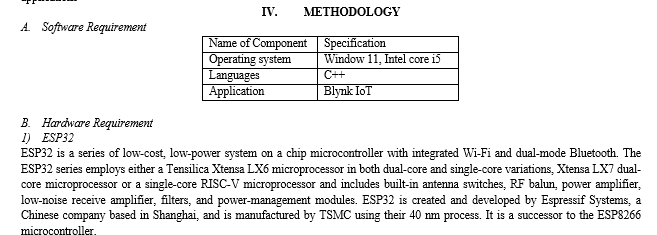
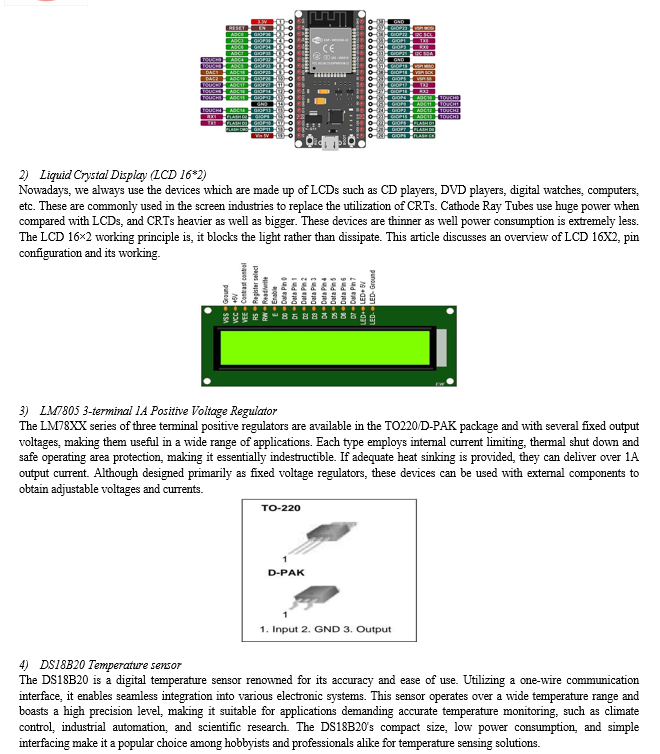

V. DESIGN AND WORKING
A. Working
- Voltage Monitoring
The BHMS continuously monitors the voltage of each individual cell within the battery pack. For multi-cell batteries, such as lithium-ion packs, this is essential for balancing the cells and preventing overcharging or undercharging. o Voltage sensors are connected across each cell or cell group, providing real-time voltage readings. o If any cell's voltage exceeds safe limits (overvoltage) or drops below a certain threshold (undervoltage), the BHMS will take corrective actions such as balancing the cells or triggering an alarm.
2. Temperature Monitoring
Temperature sensors are placed strategically within the battery pack to monitor the temperature of the cells. o Overheating can lead to reduced battery life, thermal runaway, or even fires in extreme cases. Hence, the BHMS continuously monitors the temperature and ensures it remains within safe limits. o If the temperature exceeds safe thresholds, the BHMS may initiate cooling systems or reduce charging/discharging rates to prevent damage.
3. Current Monitoring
Current sensors measure the flow of current into and out of the battery pack.
Monitoring current helps the BHMS track the state of charge (SoC) and state of health (SoH) of the battery. o Overcurrent conditions (e.g., during rapid charging or discharging) can stress the battery and reduce its lifespan. The BHMS intervenes by limiting the current flow to safe levels.
4. State of Charge (SoC) Estimation
Using data from voltage, current, and temperature sensors, the BHMS estimates the state of charge of the battery.
SoC estimation is crucial for providing accurate information to the user about the remaining battery capacity. o Advanced algorithms, such as coulomb counting, Kalman filters, or neural networks, may be employed for precise SoC estimation.
5. State of Health (SoH) Monitoring
SoH represents the overall health and performance capability of the battery over its lifetime.
The BHMS tracks factors such as capacity degradation, internal resistance, and cycle count to assess SoH.
By monitoring SoH, the BHMS can provide predictive maintenance alerts and optimize battery usage for longevity.
6. Cell Balancing
In multi-cell battery packs, cell balancing ensures that all cells are charged and discharged evenly, preventing overcharging of certain cells.
The BHMS controls balancing circuits or switches to redistribute energy among cells, ensuring they all reach the same voltage level.
7. Safety Protection
In case of critical faults or hazardous conditions like overvoltage, undervoltage, overcurrent, or over-temperature, the BHMS implements safety protocols. o Safety measures may include disconnecting the battery from the load, activating cooling systems, or triggering alarms to alert users.
8. Data Logging and Communication
The BHMS often includes data logging capabilities to record battery performance parameters over time.
It communicates with external systems, such as vehicle controllers or energy management systems, to provide real-time data and receive commands for controlling battery operation.
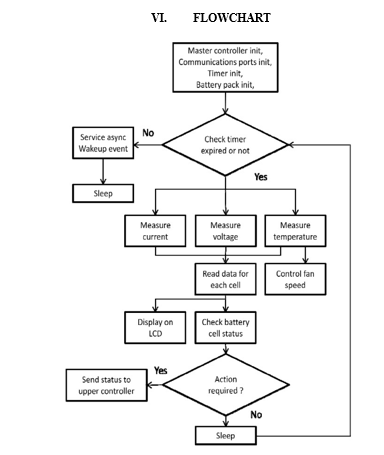

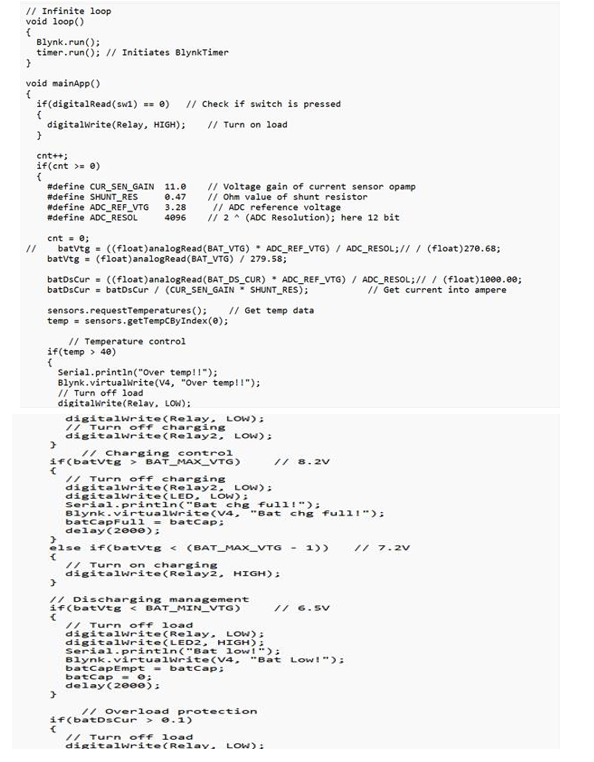
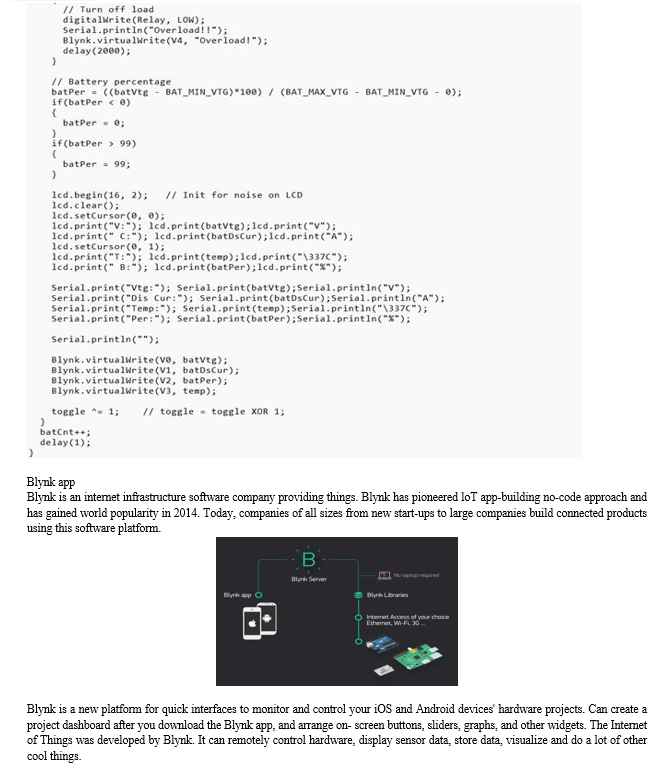

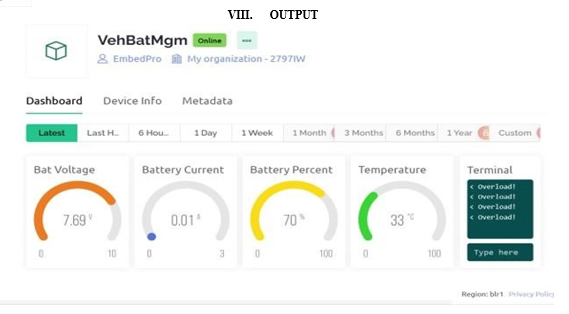
- We protect battery from overcurrent damage.
- Automatically load turns off when battery temperature.
- We can do real time monitoring of battery from anywhere in the world through Blynk IOT platform.
- Battery charging will stop when it is fully charged.
IX. ADVANTAGES OF THE PROJECT
- Battery Protection: One of the primary functions of a BHMS is to protect the battery from various damaging conditions such as overcharging, over discharging, and overcurrent. It ensures that the battery operates within safe voltage and temperature limits, thereby extending its lifespan.
- State of Charge (SoC) Estimation: BHMS systems typically include algorithms to estimate the State of Charge of the battery accurately. This estimation is crucial for providing users with accurate information about the remaining energy in the battery and optimizing its usage.
- Cell Balancing: In multi-cell battery packs, individual cells can have different capacities or states of charge, leading to imbalances that affect overall performance and lifespan. BHMS systems manage cell balancing, ensuring that each cell is charged and discharged evenly to maximize pack efficiency and longevity.
- Temperature Monitoring and Control: Overheating can degrade battery performance and safety. BHMS systems monitor battery temperature and may implement thermal management strategies such as cooling or heating to maintain optimal operating conditions.
- Fault Detection and Diagnosis: BHMS systems continuously monitor battery performance and can detect faults or abnormalities such as cell failures, voltage irregularities, or internal shorts. Prompt detection allows for early intervention to prevent further damage or safety hazards.
- Safety Features: BHMS systems incorporate safety features such as temperature sensors, voltage monitors, and current limiters to ensure safe operation and prevent hazardous conditions like thermal runaway or fire.
- Communication and Data Logging: Many BHMS systems include communication interfaces (e.g., CAN bus, UART) for interaction with external systems or user interfaces. They may also log data related to battery performance, usage patterns, and fault events for analysis and diagnostics.
- Integration with Energy Management Systems: BHMS systems can integrate with energy management systems to coordinate charging, discharging, and power flow optimization.
X. APPLICATIONS
- Electric Vehicles (EVs): BHMS ensures safe and efficient operation of the battery pack in electric vehicles by monitoring parameters such as SoC, SoH, temperature, voltage, and current. It manages charging and discharging processes, preventing overcharging, deep discharging, and thermal runaway. BHMS optimizes battery performance and extends battery life, contributing to the overall reliability and range of electric vehicles.
- Renewable Energy Storage: In grid-connected or off-grid renewable energy systems, BHMS manages battery storage by monitoring energy flow, voltage, and temperature. It coordinates charging and discharging cycles based on energy demand and supply, maximizing the utilization of renewable energy sources and ensuring grid stability. BHMS facilitates integration with solar, wind, or other renewable energy sources, providing backup power and grid support services.
- Consumer Electronics: BHMS is employed in smartphones, laptops, tablets, and other portable electronic devices to monitor and manage battery performance. It optimizes charging processes, prevents overcharging, and protects the battery from overcurrent and overheating, enhancing the safety and lifespan of the device's battery.
- Telecommunications: BHMS is used in telecom towers and backup power systems to manage battery banks that provide uninterrupted power supply during outages. It monitors battery health, ensures optimal charging and discharging, and sends alerts in case of abnormal conditions, minimizing downtime and service disruptions.
- Marine and Aerospace Applications: BHMS is essential in marine vessels, aircraft, and spacecraft to manage battery systems powering propulsion, navigation, and auxiliary equipment. It ensures safe operation under harsh environmental conditions, monitors critical parameters, and implements fail-safe mechanisms to prevent catastrophic failures.
- Industrial Equipment and UPS: BHMS is integrated into industrial machinery, UPS (Uninterruptible Power Supply) systems, and backup power solutions to monitor and control battery performance. It optimizes energy usage, manages battery charging and discharging profiles, and provides diagnostics to prevent unexpected downtime and equipment damage.
- rid-Scale Energy Storage: BHMS plays a crucial role in large-scale energy storage systems deployed for grid stabilization, peak shaving, and renewable energy integration. It manages battery arrays, coordinates charge/discharge cycles, and participates in grid frequency regulation to support the reliable operation of the electrical grid.
A. Future Scope
- We can add alert system in BHMS using buzzers and such other indicators.
- We can add notification system to the BHMS.
- For cooling purpose when battery is overheated, we can add automated cooling system.
- We can implement switch-over of batteries till the latter battery gets charged.
Conclusion
The Battery Health Monitoring System (BHMS) is a critical component in the efficient and safe operation of battery systems. Throughout this report, we have examined various aspects of BHMS, including its functions, components, and importance in different applications. From monitoring cell voltage and temperature to balancing cell capacities and controlling charging and discharging currents, the BMS plays a pivotal role in maximizing battery performance and lifespan while ensuring safety. Additionally, advancements in BMS technology, such as the integration of state-of-the-art algorithms and communication protocols, have enhanced its capabilities in managing complex battery systems, especially in electric vehicles and renewable energy storage systems. However, challenges such as thermal management, cell aging, and reliability continue to drive research and development efforts in the field of battery management. Moving forward, as the demand for energy storage solutions grows, further innovations and improvements in BHMS will be crucial for meeting the evolving needs of various industries and ensuring the sustainable and efficient utilization of battery resources.
References
[1] Sen, c., & kar, n. C. (2009, september). Battery pack modeling for the analysis of battery management system of a hybrid electric vehicle. In 2009 ieee vehicle power and propulsion conference (pp. 207- 212). ????. [2] N. K. Ure, g. Chowdhary, t. Toksoz, j. P. How, m. A. Vavrinaand j. Vian, \"an automated battery management system to enable persistent missions with multiple aerial vehicles,\" in ieee/asme transactions on mechatronics, vol. 20, no. 1, pp.275-286, feb. 2015. [3] Rahmon, a. Ebn and helmuth biechl. Modelling of li- ion batteries using equivalent circuit. Diagrams. Przegl?d electrotechnics (2012): 152-156. [4] Chatzakis, j, kalaitzakis, k, voulgaris, n. C., & manias,s. N. (2003). Designing a new generalized battery management system. Ieee transactions on industrial electronics, 50(5), 990-999. [5] Prof. Smt.ch.trinayani, avala prasanth, b.sai pujitha, a.dinesh, k.ranjith, 2024, cloud based substation monitoring and controlling unit, international journal of engineering research & technology (ijert) volume 13, issue 04 (april 2024), [6] Diya mariam jose , veena vijayakumar , athulya s , surasmi n l , hridya c k, 2021, hybrid energy storage system for electric vehicles, international journal of engineering research & technology (ijert) volume 10, issue 06 (june 2021), [7] Ravi choudhary, 2021, electric battery life state of health models for electric vehicles, international journal of engineering research & technology (ijert) nccds – 2021 (volume 09 – issue 12), [8] Nuria novas, rosa m. Garcia salvador global perspectives on and research challenges for electric vehicles, published: 3 november 2022 [google scholar] [9] Prof. N. S. Mahajan, dr. V. S. Patil, muskan ahamad tadavi, charul prashant sonar, 2023, advance manless e-vehicle charging station, international journal of engineering research & technology (ijert) volume 12, issue 05 (may 2023), [10] Savitra c t, hemanth kumar e naik, hoysala bise, sachin k r, kiran j y, 2022, wireless charging and battery management for ev using arduino, international journal of engineering research & technology (ijert) icei – 2022 (volume 10 – issue 11),
Copyright
Copyright © 2024 Prashant Siddappa Gurupadagol, Umesh Kalagonda Patil. This is an open access article distributed under the Creative Commons Attribution License, which permits unrestricted use, distribution, and reproduction in any medium, provided the original work is properly cited.

Download Paper
Paper Id : IJRASET61325
Publish Date : 2024-04-30
ISSN : 2321-9653
Publisher Name : IJRASET
DOI Link : Click Here
 Submit Paper Online
Submit Paper Online

